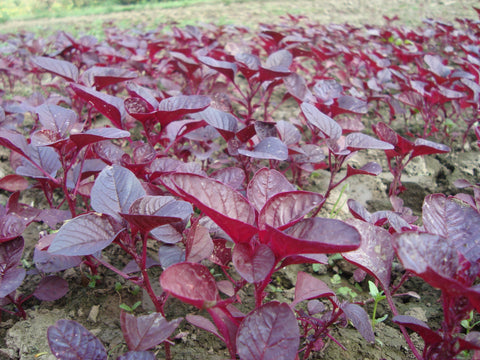12 Nitrate-Rich Vegetables To Boost Nitric Oxide
There are only a handful of actions we can count on to legitimately add more years to our life. One of those is, of course, eating our vegetables. Studies show that an additional 8-10 years can be added to life by increasing veggie-eating habits. Though most anyone can recite the public health message to “eat more vegetables,” less than 9.3% of all adults in the U.S. actually meet the minimum recommended vegetable intake, according to a CDC (Center for Diseases Control) Morbidity and Mortality Report.
Every vegetable has its place in a balanced plant-based diet, but some supercharged vegetables can add an intense boost to overall health - those are nitrate-rich vegetables.
Why are nitrate-rich vegetables important?

Before the discovery of nitric oxide’s signaling properties as a health factor in 1998 by the three scientists Dr. Louis Ignarro, Robert F. Furchgott, and Ferid Murad, nitrate was something people thought should be avoided. There were blanket misconceptions about how nitrate should be avoided, whether it was found in water oras a preservative in meat. Since then, extensive research has proven that nitrate is not only good for optimal health; it’s a vital dietary component that is naturally occurring in vegetables. Dietary nitrate in the body converts to nitric oxide, a fundamental manager of optimal health.
Why it’s best to source nitrate from vegetables

Meat with added nitrate and nitrite as a preservative is rightfully associated with poor health; prime examples are ham, bacon, deli meats, and hotdogs. But it’s not the presence of nitrate that is the real danger. Rather, it’s the lack of antioxidants, minerals, and vitamins that, by comparison, are abundant in vegetables and fruits. Vegetables contain considerably more natural nitrate than meat, are obviously healthier, and are by contrast well documented to increase health and longevity. Research from nitrate experts such as our own science advisor Norman Hord published in The American Journal of Clinical Nutrition shows that it’s the constituents that makeup vegetables like nitrate, vitamins, phytochemicals, glucosinolates, minerals, and fibers that are responsible for the balanced positive impact on health. This is why nitrate-rich vegetables are the superior source for boosting nitric oxide and why it’s imperative to eat your veggies.
12 Nitrate-Rich Vegetables
The main source of dietary nitrate comes from vegetables, and the list below represents the richest sources of nitrate for a superior nitric oxide boost.
Beetroot & Beet Greens - Beets are widely studied for their nitrate content, but beet greens are also an incredibly rich source of nitrate and can be cooked and eaten much like greens without loss of nitrate content.
Red Spinach - Red Spinach is so rich in nitrate that 400mg has been proven to boost athletic and cognitive performance by increasing nitric oxide levels for at least eight hours. People who eat 400 mg of red spinach generate more power, higher speeds, and use less oxygen. What gives red spinach its color is betacyanin which offers antioxidant, anti-inflammatory, and detoxification support.
Arugula - also called “rocket,” is one of the top cruciferous leafy greens with a healthy source of nitrate.
Bok Choy - Also called pak choi, contains good amounts of nitrate. Containing iron, phosphorus, calcium, magnesium, zinc, and vitamin K, bok choy helps maintain bone strength.
Broccoli - As part of the cruciferous family, broccoli is a great source of nitrate and contains a well-studied phytochemical called “sulforaphane” that has shown remarkable antioxidant power.
Celery - Celery contains a phytochemical called phthalides. Celery extract has been shown to relax the tissues of the artery walls and increase blood flow.
Swiss Chard - A rich in nitrate, vitamin A, vitamin K, beta-carotene, biotin, vitamin H, which supports the body in converting food to energy.
Green Spinach - Eating raw green spinach helps maintain nitrate levels by 50% versus cooking. Research shows, just one cup of green spinach a day can boost muscle function and increase salivary nitrate levels eight times.
Kale - Kale is a popular nitrate-rich leafy green. Not only is it beneficial to overall health, it also supports oral health. Chewing kale helps maintain a healthy oral microbiome.
Mustard Greens - Contain antioxidants like flavonoids and beta carotene, vitamins A, C, K, and nitrate, mustard greens necessary for improving cardiovascular health.
Rhubard - A free radical fighting stem plant, Rhubarb packs a substantial punch of nitrate in every serving. The active stilbenes (rhapontigenin, piceatannol, resveratrol) in rhubarb are credited for increasing nitric oxide levels.
Spirulina - Considered an extremely beneficial food for health and protecting the heart, spirulina is especially high inSP3-SP6 peptides that increase nitric oxide levels and drastically support blood flow.
How much nitrate for max benefit
When it comes to optimizing overall health, studies show just one cup of nitrate-rich raw vegetables or equivalent juice consumed daily can improve vasodilation and cardiovascular health. For sports performance, it has been determined that 400 mg of nitrate in a serving is an ideal number for increased endurance For getting this amount of nitrate from vegetables in one serving and often throughout the day, it’s best to supplement.
Resources
Fraser, G. E., & Shavlik, D. J. (2001). Ten years of life: Is it a matter of choice?. Archives of internal medicine, 161(13), 1645–1652. https://doi.org/10.1001/archinte.161.13.1645
Seung Hee Lee-Kwan, PhD1; Latetia V. Moore, PhD1; Heidi M. Blanck, PhD1; Diane M. Harris, PhD1; Deb Galuska, PhD. Disparities in State-Specific Adult Fruit and Vegetable Consumption — United States, 2015. Weekly / November 17, 2017 / 66(45);1241–1247. https://www.cdc.gov/mmwr/volumes/66/wr/mm6645a1.htm?s_cid=mm6645a1_w
Norman G Hord, Yaoping Tang, Nathan S Bryan, Food sources of nitrates and nitrites: the physiologic context for potential health benefits, The American Journal of Clinical Nutrition, Volume 90, Issue 1, July 2009, Pages 1–10, https://doi.org/10.3945/ajcn.2008.27131
Brkić, D., Bošnir, J., Bevardi, M., Bošković, A. G., Miloš, S., Lasić, D., Krivohlavek, A., Racz, A., Ćuić, A. M., & Trstenjak, N. U. (2017). NITRATE IN LEAFY GREEN VEGETABLES AND ESTIMATED INTAKE. African journal of traditional, complementary, and alternative medicines : AJTCAM, 14(3), 31–41. https://doi.org/10.21010/ajtcam.v14i3.4
Bondonno, C.P., Dalgaard, F., Blekkenhorst, L.C. et al. Vegetable nitrate intake, blood pressure and incident cardiovascular disease: Danish Diet, Cancer, and Health Study. Eur J Epidemiol 36, 813–825 (2021). https://doi.org/10.1007/s10654-021-00747-3
González-Soltero, R., Bailén, M., de Lucas, B., Ramírez-Goercke, M. I., Pareja-Galeano, H., & Larrosa, M. (2020). Role of Oral and Gut Microbiota in Dietary Nitrate Metabolism and Its Impact on Sports Performance. Nutrients, 12(12), 3611. https://doi.org/10.3390/nu12123611
Kobayashi, J., Ohtake, K., & Uchida, H. (2015). NO-Rich Diet for Lifestyle-Related Diseases. Nutrients, 7(6), 4911–4937. https://doi.org/10.3390/nu7064911
Frazie, M. D., Kim, M. J., & Ku, K. M. (2017). Health-Promoting Phytochemicals from 11 Mustard Cultivars at Baby Leaf and Mature Stages. Molecules (Basel, Switzerland), 22(10), 1749. https://doi.org/10.3390/molecules22101749
Subramanian, D., & Gupta, S. (2016). Pharmacokinetic study of amaranth extract in healthy humans: A randomized trial. Nutrition (Burbank, Los Angeles County, Calif.), 32(7-8), 748–753. https://doi.org/10.1016/j.nut.2015.12.041
Stanaway, L., Rutherfurd-Markwick, K., Page, R., & Ali, A. (2017). Performance and Health Benefits of Dietary Nitrate Supplementation in Older Adults: A Systematic Review. Nutrients, 9(11), 1171. https://doi.org/10.3390/nu9111171
Klinge, C. M., Wickramasinghe, N. S., Ivanova, M. M., & Dougherty, S. M. (2008). Resveratrol stimulates nitric oxide production by increasing estrogen receptor alpha-Src-caveolin-1 interaction and phosphorylation in human umbilical vein endothelial cells. FASEB journal : official publication of the Federation of American Societies for Experimental Biology, 22(7), 2185–2197. https://doi.org/10.1096/fj.07-103366
Juárez-Oropeza, M. A., Mascher, D., Torres-Durán, P. V., Farias, J. M., & Paredes-Carbajal, M. C. (2009). Effects of dietary Spirulina on vascular reactivity. Journal of medicinal food, 12(1), 15–20. https://doi.org/10.1089/jmf.2007.0713
Meamarbashi, A., & Alipour, M. (2014). Moderate dose of watercress and red radish does not reduce oxygen consumption during graded exhaustive exercise. Avicenna journal of phytomedicine, 4(4), 267–272.
Potter, A. S., Foroudi, S., Stamatikos, A., Patil, B. S., & Deyhim, F. (2011). Drinking carrot juice increases total antioxidant status and decreases lipid peroxidation in adults. Nutrition journal, 10, 96. https://doi.org/10.1186/1475-2891-10-96
Edith Cowan University. (2021, May 4). One cup of leafy green vegetables a day lowers risk of heart disease. ScienceDaily. Retrieved November 4, 2021 from www.sciencedaily.com/releases/2021/05/210504112604.htm





Comments (0)
There are no comments for this article. Be the first one to leave a message!